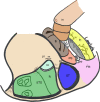Variability of the retrotympanum and its association with mastoid pneumatization in cholesteatoma patients
- PMID: 35695918
- PMCID: PMC9813076
- DOI: 10.1007/s00405-022-07465-w
Variability of the retrotympanum and its association with mastoid pneumatization in cholesteatoma patients
Abstract
Purpose: This study aimed to investigate the variability of the retrotympanum in patients undergoing surgical treatment for cholesteatoma.
Methods: We included 59 ears of patients undergoing middle ear surgery for cholesteatoma who had preoperative computed tomography scans. A retrospective analysis of the medical records was conducted. The sinus tympani (ST), subtympanic sinus (STS) and facial recess (FR) were classified into types A-C based on the relationship of their extension to the facial nerve. The mastoid and petrous apex were assessed and categorized as normal pneumatized or sclerotic.
Results: Type A extension was the most frequently found in all sinuses (ST 64%, FR 77%, STS 69%), Type B extension was found more often in ST (34%) and STS (24%) than in FR (15%). A very deep extension was found only rarely (ST 2%, FR 8%, STS 7%). A sclerotic mastoid was found in 67% of cases. Those cases showed a statistically significant difference regarding retrotympanum pneumatization when compared with normal mastoid.
Conclusion: The most frequent variant of retrotympanic pneumatization in relation to the facial nerve was type A in all subsites in cholesteatoma patients. The variability among patients with cholesteatoma is different to previously published results in healthy subjects. Moreover, the pneumatization of the retrotympanum is associated with mastoid pneumatization.
Keywords: Cholesteatoma; Endoscopic ear surgery; Pneumatization; Retrotympanum; Temporal bone anatomy.
© 2022. The Author(s).
Conflict of interest statement
L. Anschuetz is a consultant physician for STRYKER ENT. He has not received any financial compensation for his contribution to this manuscript.
Figures




Similar articles
-
Accuracy of High-Resolution Computed Tomography Compared to High-Definition Ear Endoscopy to Assess Cholesteatoma Extension.Otolaryngol Head Neck Surg. 2023 Nov;169(5):1276-1281. doi: 10.1002/ohn.413. Epub 2023 Jul 7. Otolaryngol Head Neck Surg. 2023. PMID: 37418100
-
Effect of mastoid bone pneumatization on the conformation and depth of the sinus tympani, a high-resolution computed tomography study.Surg Radiol Anat. 2019 Aug;41(8):921-926. doi: 10.1007/s00276-019-02246-3. Epub 2019 Apr 29. Surg Radiol Anat. 2019. PMID: 31037347
-
Correlation of Radiologic Versus Endoscopic Visualization of the Middle Ear: Implications for Endoscopic Ear Surgery.Otol Neurotol. 2020 Oct;41(9):e1122-e1127. doi: 10.1097/MAO.0000000000002787. Otol Neurotol. 2020. PMID: 32925849
-
Management of Cholesteatoma: Extension Beyond Middle Ear/Mastoid.Otolaryngol Clin North Am. 2025 Feb;58(1):89-98. doi: 10.1016/j.otc.2024.07.025. Epub 2024 Sep 6. Otolaryngol Clin North Am. 2025. PMID: 39244458 Review.
-
Treatment of cholesteatoma and retraction pockets.Eur Arch Otorhinolaryngol. 1993;250(4):193-9. doi: 10.1007/BF00171523. Eur Arch Otorhinolaryngol. 1993. PMID: 8369113 Review.
Cited by
-
Radioanatomical evaluation of the subtympanic sinus in children under five years old and its clinical implications - high resolution computed tomography study.Surg Radiol Anat. 2024 Dec;46(12):1965-1975. doi: 10.1007/s00276-024-03508-5. Epub 2024 Oct 23. Surg Radiol Anat. 2024. PMID: 39441351 Free PMC article.
-
The posterior-inferior recess of the sinus tympani - radioanatomical investigation for purposes of endoscopic otosurgery in children under five.Eur Arch Otorhinolaryngol. 2025 Jul 12. doi: 10.1007/s00405-025-09558-8. Online ahead of print. Eur Arch Otorhinolaryngol. 2025. PMID: 40652133
References
MeSH terms
LinkOut - more resources
Full Text Sources
Miscellaneous

